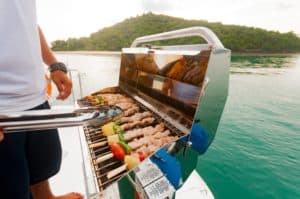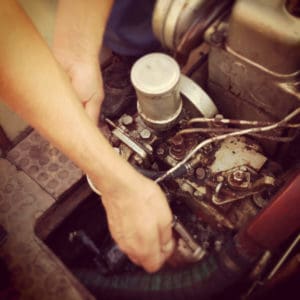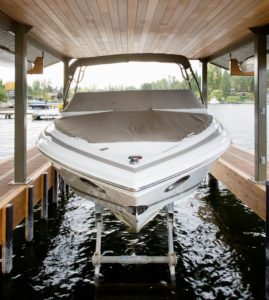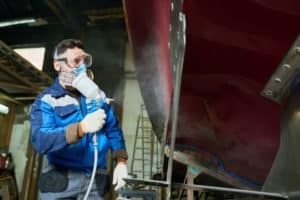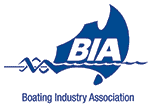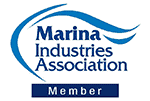Whether you have a motor yacht or a sailing yacht, you probably have an engine that drives a propellor. You know that your boat and boat engine need regular maintenance, still, many yacht owners and even yacht charterers are unaware of how and why to maintain a propellor.
Whether you have an inboard diesel engine or an outboard petrol engine, it is essential to your boat’s power, performance efficiency, safety and longevity that you have a proper maintenance schedule for your propellor.
Your boat will travel further on less fuel with proper care and maintenance. It will go faster, handle better, accelerate more quickly, require less engine maintenance, be more comfortable and get you home safe and sound.
I remember, years ago, walking the quays in the marina at Antibes on the Cote de Azur in the South of France. I was a young marine engineer just out of the Royal Navy and looking for work. I overheard a conversation between the owners of two enormous powerboats. One of them was complaining that his boat was discharging black smoke, and nobody could work out why. Boat mechanics had inspected the boat, and they could find nothing wrong with the engine. I strolled over and engaged with the two sailors.
“Excuse me, but I couldn’t help overhearing your conversation”, I commented.
“I’ve had the best engineers in Antibes look at these engines, and I just don’t know what’s wrong”, replied the owner.
“When was the last time you inspected the propellors?” I asked
The powerboat owner looked at me blankly.
“The propellors?”
“Yes!” I replied. “If your propellor is dirty, damaged or encrusted with barnacles and other sea creatures, it puts extra strain on your engine. If your motor has stress like that, it will discharge black smoke, become inefficient and use more fuel.”
The boat owner had spent a fortune on diesel mechanics when all he needed to do was clean the propellors.
If you are into boating life, you may be able (and want) to do some of the scheduling and boat maintenance yourself. However, it is advisable to consult a qualified boat maintenance team, especially if you are berthed in a marina. It is always safer to comply with maritime law and marina rules and have boat work carried out by a qualified marine engineer. These services are available at the Elizabeth Bay Marina and the Long Island Marina. It is usually easier to have the boat lifted and clean the prop on the hard. However, a qualified diver can often work with the boat in the water, saving time, energy and money.
Propellor types
Not all boat propellors are the same. There are six main types of pleasure boat propellors. These depend on the type of boat, type of engine and the use both are put to. You might have an aluminium, plastic, brass or stainless-steel propellor. It could be a chopper, a cleaver, or a high-reverse thrust.
Propellor construction material aside, there are three types of blades for boat propellors.
The most common design is round-eared blades. These are designed to operate when fully submerged. However, they can be partially on the surface when driving a light load.
For waterways and coastal waters with a lot of vegetable growth (seaweed etc.), a weedless propellor is more appropriate. The edges of the blade sweep backwards to avoid being snagged by weeds.
A cleaver propellor is used when the engine is mounted in a high position relative to the waterline, and the propellor may run out of the water at times.
When to maintain and repair your propellor
- When you hit an obstacle in the water. It is not uncommon for pleasure boats to hit a sand bar, corral, rocks or other objects on the sea or river bed. There is also the additional hazard of debris floating on or below the surface. If the impact bends the blades, your engine will be put under undue stress, and the lack of balance may damage the transmission or engine itself.
- When your propellor or shaft gets entangled with fishing line or other lines, rope and string, this can have similar effects to hitting obstacles.
- When you notice decreased fuel efficiency or black exhaust smoke.
- Scheduled maintenance inspection. Water corrodes, and saltwater corrodes more. Propellors become pitted and require polishing or replacing. Both aluminium and bronze propellors corrode quickly. Stainless steel is also susceptible to corrosion, but less so. Consider replacing your old propellor with a stainless-steel one.
How to maintain your propellor
Make an appointment at a reputable marine (such as Corleone Marinas) and talk to a qualified marine engineer. They will arrange a schedule for checking for damage, wear, corrosion and other defects to keep your propellor in excellent shape.
If you have the opportunity (and the inclination), visually inspect your propellor(s) yourself. Look out for dents, dings, nicks, missing paint or any other sign of foreign object damage. Check for signs of wear such as missing paint, sharpened or pointed blades or blunt edges, especially on the leading sides (the tip of the border which cuts the water first).
You can probably repair minor damage such as dents or nicks yourself. Smooth out the dents or nicks and make sure the propellor is clean. Be careful to ensure that the propellor is balanced. If not, it could damage the propellor shaft, the transmission or the engine.
Remove any fishing lines, ropes, plastic bags or other entangled objects from the propellor and the shaft.
Check the hub and seal on outboard engines and the stern gland on inboard engines. Look for signs of perished rubber, gunk or other indicators of damaged or worn seals.
Consult a professional
A stitch in time saves nine. A neglected propellor (or anything else neglected on a boat) produces danger and inefficiency. The longer you leave it, the more it will cost to fix it. It is good practice to inspect your boat before and after every voyage. It is essential to have the right team of mechanical and electrical engineers, shipwrights and other maintenance staff to design and carry out a regular maintenance schedule to keep you safe and save you money. Corleone Marina provides all the services needed by discerning boat owners. Check them out and make an appointment at the earliest opportunity. Happy sailing!



